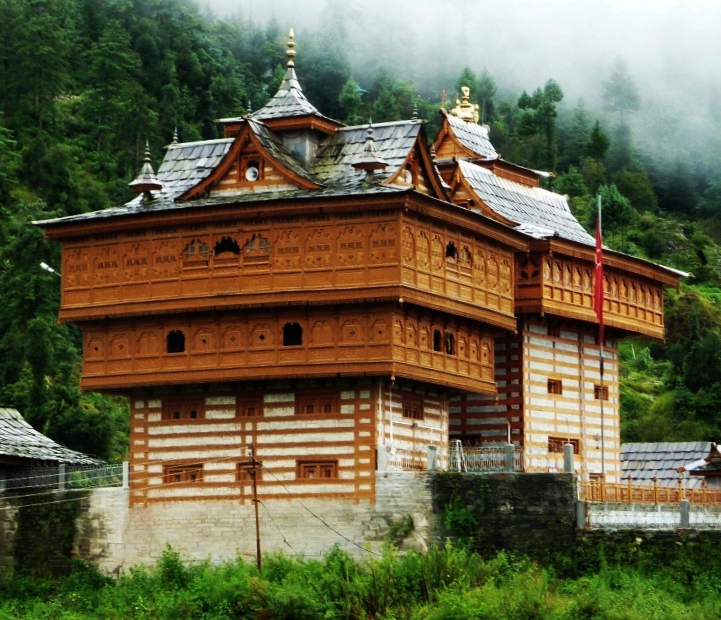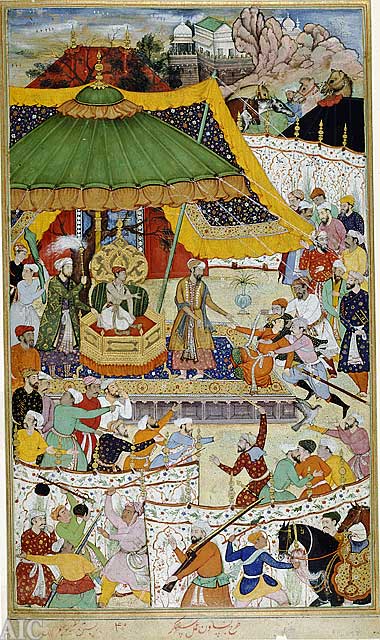|
Adamwahan
Adamwahan is a village in Lodhran Tehsil of Lodhran District in Punjab, Pakistan. It was the seat of a pargana in the late 16th century. History Ādamwāhan was listed in the Ain-i-Akbari as a pargana in sarkar Multan, counted as part of the Bet Jalandhar Doab. It was assessed at 369,445 dams in revenue and supplied a force of 30 cavalry and 700 infantry. Demographics As of the 2017 Census of Pakistan, Adamwahan had a population of 9,869 (5,060 male, 4,804 female, and 5 other). The average household size was 7.22 people. In terms of age distribution, 32.1% of Adamwahan residents were under age 10 in 2017 (3,167 in total); 18.9% were between 10 and 18 (1,870 in total); 43.8% were between 18 and 60 (4,327 in total); and 5.1% were over the age of 60 (505 in total). The village's working population was 694 (not counting children under the age of 10). In terms of religion, all 9,869 residents were Muslim. The overall literacy rate in the village was 39.88% (49.64% among males an ... [...More Info...] [...Related Items...] OR: [Wikipedia] [Google] [Baidu] |
Adamwahan Bridge Railway Station
Adamwahan Bridge railway station ( ur, ) is a railway station located in Adamwahan, Lodhran District, Pakistan. See also * List of railway stations in Pakistan * Pakistan Railways Pakistan Railways ( ur, ) is the national, state-owned railway company of Pakistan. Founded in 1861 and headquartered in Lahore, it owns of track across Pakistan, stretching from Torkham to Karachi, offering both freight and passenger servic ... References Railway stations in Pakistan {{PunjabPK-railstation-stub ... [...More Info...] [...Related Items...] OR: [Wikipedia] [Google] [Baidu] |
Administrative Units Of Pakistan
The administrative units of Pakistan comprise four provinces, one federal territory, and two disputed territories: the provinces of Punjab, Sindh, Khyber Pakhtunkhwa, and Balochistan; the Islamabad Capital Territory; and the administrative territories of Azad Jammu and Kashmir and Gilgit–Baltistan. As part of the Kashmir conflict with neighbouring India, Pakistan has also claimed sovereignty over the Indian-controlled territories of Jammu and Kashmir and Ladakh since the First Kashmir War of 1947–1948, but has never exercised administrative authority over either region. All of Pakistan's provinces and territories are subdivided into divisions, which are further subdivided into districts, and then tehsils, which are again further subdivided into union councils. History of Pakistan Early history Pakistan inherited the territory comprising its current provinces from the British Raj following the Partition of India on 14 August 1947. Two days after independenc ... [...More Info...] [...Related Items...] OR: [Wikipedia] [Google] [Baidu] |
Sarkar (administrative Division)
Sarkar ( hi, , ur, , pa, ਸਰਕਾਰ, bn, সরকার also spelt Circar) is a historical administrative division, used mostly in the Mughal Empire. It was a division of a Subah or province. A sarkar was further divided into Mahallas or Parganas. The Sarkar system was replaced in the early 18th century by the Chakla system. See also * Northern Circars The Northern Circars (also spelt Sarkars) was a division of British India's Madras Presidency. It consisted of a narrow slip of territory lying along the western side of the Bay of Bengal from 15° 40′ to 20° 17′ north latitude, in the pre ..., the five individual districts making up a former division of British India's Madras Presidency * Rajamundry Sarkar, one among the Northern Circars * Pakhli, an ancient sarkar now part of Hazara, Pakistan * Pakhal Sarkar, an area of Mansehra district in Khyber Pakhtunkhwa, Pakistan References Subdivisions of the Mughal Empire Former subdivisions of Bangladesh< ... [...More Info...] [...Related Items...] OR: [Wikipedia] [Google] [Baidu] |
Indian Vernacular Architecture
Indian vernacular architecture the informal, functional architecture of structures, often in rural areas of India, built of local materials and designed to meet the needs of the local people. The builders of these structures are unschooled in formal architectural design and their work reflects the rich diversity of India's climate, locally available building materials, and the intricate variations in local social customs and craftsmanship. It has been estimated that worldwide close to 90% of all building is vernacular, meaning that it is for daily use for ordinary, local people and built by local craftsmen. The term vernacular architecture in general refers to the informal building of structures through traditional building methods by local builders without using the services of a professional architect. It is the most widespread form of building. In India there are numerous traditional regional styles, although there is much in common in the styles of the Hindi belt in the nor ... [...More Info...] [...Related Items...] OR: [Wikipedia] [Google] [Baidu] |
Matriculation
Matriculation is the formal process of entering a university, or of becoming eligible to enter by fulfilling certain academic requirements such as a matriculation examination. Australia In Australia, the term "matriculation" is seldom used now. In the late 1960s and early 1970s, all states replaced the matriculation examination with either a certificate, such as the Higher School Certificate (HSC) in Victoria and NSW, or a university entrance exam such as the Tertiary Entrance Exam in Western Australia. These have all been renamed (except in NSW) as a state-based certificate, such as the Victorian Certificate of Education (VCE) or the Western Australian Certificate of Education (WACE). Bangladesh In Bangladesh, the "Matriculation" is the Secondary School Examination (SSC) taken at year 10, and the Intermediate Exams is the Higher Secondary Examination (HSC) taken at year 12. Bangladesh, like the rest of Indian sub-continent, still uses terms such as Matriculation Exams and I ... [...More Info...] [...Related Items...] OR: [Wikipedia] [Google] [Baidu] |
Primary School
A primary school (in Ireland, the United Kingdom, Australia, Trinidad and Tobago, Jamaica, and South Africa), junior school (in Australia), elementary school or grade school (in North America and the Philippines) is a school for primary education of children who are four to eleven years of age. Primary schooling follows pre-school and precedes secondary schooling. The International Standard Classification of Education considers primary education as a single phase where programmes are typically designed to provide fundamental skills in reading, writing, and mathematics and to establish a solid foundation for learning. This is ISCED Level 1: Primary education or first stage of basic education.Annex III in the ISCED 2011 English.pdf Navigate to International Standard Classification of Educati ... [...More Info...] [...Related Items...] OR: [Wikipedia] [Google] [Baidu] |
Dam (Indian Coin)
A dam was a small Indian copper coin. The coin was first introduced by Sher Shah Suri during his rule of India between 1540 and 1545, along with '' Mohur'', the gold coin and '' Rupiya'' the silver coin. Later on, the Mughal Emperors The Mughal emperors ( fa, , Pādishāhān) were the supreme heads of state of the Mughal Empire on the Indian subcontinent, mainly corresponding to the modern countries of India, Pakistan, Afghanistan and Bangladesh. The Mughal rulers styled ... standardised the coin along with other silver ''( Rupiya)'' and gold ''( Mohur)'' coins in order to consolidate the monetary system across India. A rupee was divided into 40 dams. It is believed that this coin is one of the possible sources for the English phrase "I don't give a dam ��, due to its small worth.Gorrell, Robert, ''Watch Your Language: Mother Tongue and Her Wayward Children'', University of Nevada Press, 1994''Watch Your Language'' at Google Books/ref> See also * Mohur * History of t ... [...More Info...] [...Related Items...] OR: [Wikipedia] [Google] [Baidu] |
Multan
Multan (; ) is a city in Punjab, Pakistan, on the bank of the Chenab River. Multan is Pakistan's seventh largest city as per the 2017 census, and the major cultural, religious and economic centre of southern Punjab. Multan is one of the oldest continuously inhabited cities in Asia, with a history stretching deep into antiquity. The ancient city was the site of the renowned Multan Sun Temple, and was besieged by Alexander the Great during the Mallian Campaign. A historic cultural centre of the wider Punjab, it was conquered by the Ummayad military commander Muhammad bin Qasim. The city later became independent as the capital of the Emirate of Multan in 855 A.D., before subsequently coming under the rule of empires such as the Ghaznavids, the Ghurids and the Mamluks. In 1445, it became capital of the Langah Sultanate. In 1526, it was conquered by the Mughal Empire. Multan Subah would become one of the largest provinces of the Mughal Empire when it was created by administrative r ... [...More Info...] [...Related Items...] OR: [Wikipedia] [Google] [Baidu] |
Ain-i-Akbari
The ''Ain-i-Akbari'' ( fa, ) or the "Administration of Akbar", is a 16th-century detailed document recording the administration of the Mughal Empire under Emperor Akbar, written by his court historian, Abu'l Fazl in the Persian language. It forms Volume III and the final part of the much larger document, the '' Akbarnama'' (''Account of Akbar''), also by Abu'l-Fazl, and is itself in three volumes. Contents The ''Ain-i-Akbari'' is the third volume of the ''Akbarnama'' containing information on Akbar's reign in the form of administrative reports, similar to a gazetteer. In Blochmann's explanation, "it contains the 'āīn' (i.e. mode of governing) of Emperor Akbar, and is in fact the administrative report and statistical return of his government as it was about 1590."Blochmann, H. (tr.) (1927, reprint 1993). ''The Ain-I Akbari by Abu'l-Fazl Allami'', Vol. I, Calcutta: The Asiatic Society, preface (first edition) The ''Ain-i-Akbari'' is divided into five books. The first book call ... [...More Info...] [...Related Items...] OR: [Wikipedia] [Google] [Baidu] |
Districts Of Pakistan
The Districts of Pakistan ( ur, ); are the third-order administrative divisions of Pakistan, below provinces and divisions, but forming the first-tier of local government. In total, there are 169 districts in Pakistan including the Capital Territory and the districts of Azad Kashmir and Gilgit Baltistan. These districts are further divided into '' Tehsils, Union Councils''. History In 1947, when Pakistan gained independence there were 124 districts. In 1969, 2 new districts (Tangail and Patuakhali) in East Pakistan were formed totalling to 126. After the Independence of Bangladesh, Pakistan lost 20 of its districts and so there were 106 districts. In 2001, the number was reduced to 102 by the merger of the 5 districts of Karachi Central, Karachi East, Karachi South, Karachi West and Malir to form Karachi District. The number of districts rose to 106 again in December 2004, when four new districts were created in the province of Sindh of which one (Umerkot) had existed ... [...More Info...] [...Related Items...] OR: [Wikipedia] [Google] [Baidu] |
Pargana
Pargana ( bn, পরগনা, , hi, परगना, ur, پرگنہ) or parganah, also spelt pergunnah during the time of the Sultanate period, Mughal times and British Raj, is a former administrative unit of the Indian subcontinent and each ''Parganas'' may or may not subdivided into some ''pirs''. Those revinue units are used primarily, but not exclusively, by the Muslim kingdoms. After independence the Parganas became equivalent to Block/ Tahsil and Pirs became Grampanchayat. ''Parganas'' were introduced by the Delhi Sultanate. As a revenue unit, a pargana consists of several ''mouzas'', which are the smallest revenue units, consisting of one or more villages and the surrounding countryside. Under the reign of Sher Shah Suri, administration of parganas was strengthened by the addition of other officers, including a ''shiqdar'' (police chief), an ''amin'' or ''munsif'' (an arbitrator who assessed and collected revenue) and a ''karkun'' (record keeper). Mughal era In th ... [...More Info...] [...Related Items...] OR: [Wikipedia] [Google] [Baidu] |
Punjab, Pakistan
Punjab (; , ) is one of the four provinces of Pakistan. Located in central-eastern region of the country, Punjab is the second-largest province of Pakistan by land area and the largest province by population. It shares land borders with the Pakistani provinces of Khyber Pakhtunkhwa to the north-west, Balochistan to the south-west and Sindh to the south, as well as Islamabad Capital Territory to the north-west and Autonomous Territory of AJK to the north. It shares an International border with the Indian states of Rajasthan and Punjab to the east and Indian-administered Kashmir to the north-east. Punjab is the most fertile province of the country as River Indus and its four major tributaries Ravi, Jhelum, Chenab and Sutlej flow through it. The province forms the bulk of the transnational Punjab region, now divided among Pakistan and India. The provincial capital is Lahore — a cultural, modern, historical, economic, and cosmopolitan centre of Pakistan. Other major ci ... [...More Info...] [...Related Items...] OR: [Wikipedia] [Google] [Baidu] |
.png)



.jpg)



